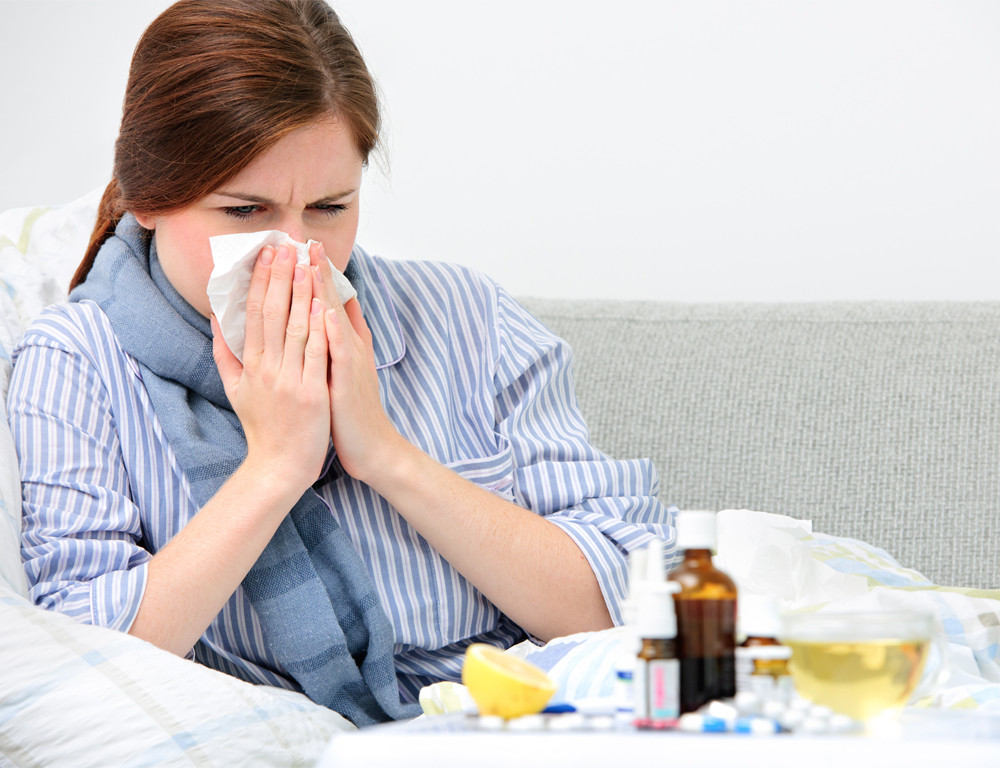Definition
The common cold is an infectious disease affecting the nose and throat (upper respiratory tract), usually caused by viruses. It can be caused by various types of viruses and is generally not dangerous. The initial signs of a common cold are typically clear, such as a stuffy or runny nose, sneezing, and a scratchy or sore throat. Most people quickly recognize these early symptoms as the common cold is a frequent occurrence in daily life.
On average, healthy adults may experience two or three episodes of the common cold each year, while infants and young children might get colds more often. Most cases of the common cold resolve on their own without specific treatment within 7 to 10 days. Symptoms may last longer in people who smoke.
The symptoms of the common cold and flu (influenza) may appear very similar initially, as both are respiratory infections and can cause similar symptoms. However, the viruses that cause them differ, and flu symptoms are typically more severe than those of the common cold. Additionally, the common cold rarely leads to additional health issues, whereas the flu can cause complications such as sinus and ear infections and pneumonia.
Causes
The common cold is fundamentally an infection caused by viruses in the upper respiratory tract. It can be caused by more than 200 types of viruses, with the most common being rhinovirus. Other viruses that can cause the common cold include respiratory syncytial virus, human parainfluenza virus, adenovirus, human coronavirus, and human metapneumovirus.
The viruses that cause the common cold enter your body through the mouth, eyes, or nose. These viruses can easily spread from person to person or from surface to surface. They can even live on surfaces for hours or days. The virus spreads through airborne droplets when someone coughs, sneezes, or talks. It can also spread through hand-to-hand contact with someone who has a common cold or by sharing contaminated items, such as utensils, towels, toys, or phones. If you touch your eyes, nose, or mouth after such contact, you are likely to catch the common cold.
Anyone can catch the common cold at any time, but it occurs more frequently in the winter or rainy seasons. During these seasons, people tend to stay indoors, increasing close contact with one another. Additionally, the cooler air can lower nasal temperatures and affect the immune system, making it harder to stop the virus from multiplying.
Risk factor
Several factors can increase your risk of catching the common cold, including:
- Age: Infants and young children (especially under six years) are at higher risk, particularly if they spend a lot of time in childcare.
- Weakened immune system: Having chronic illnesses or a weakened immune system increases the risk of catching the common cold.
- Season: Both children and adults are more likely to catch a cold in winter or rainy seasons, although it can occur at any time.
- Smoking: Smokers or those exposed to secondhand smoke are more likely to catch a cold and experience more severe symptoms.
- Environment: Frequent exposure to crowds, such as in schools, concerts, or airplanes, increases the likelihood of exposure to the cold virus.
- Lack of sleep: Poor or insufficient sleep can affect your immune system, making you more susceptible to the common cold.
Symptoms
Cold symptoms usually appear one to three days after exposure to the virus and can vary among individuals. Symptoms may include:
- Runny or stuffy nose (rhinorrhea)
- Post-nasal drip (mucus running down the back of the throat)
- Sore throat
- Cough
- Sneezing
- Loss of smell or taste
- Body aches
- Headache
- Watery eyes
- Low-grade fever
- General malaise and fatigue
Cold symptoms usually last 7 to 10 days, peaking around day 5 and gradually improving.
Diagnosis
To diagnose a common cold, a doctor will begin by asking about your symptoms and performing a physical examination. They will check for swelling in the nasal passages, nasal congestion, signs of throat inflammation (swelling, redness), and listen to your breathing with a stethoscope. Typically, a common cold is diagnosed based on the signs and symptoms you exhibit. If a bacterial infection or other condition is suspected, additional tests such as a chest X-ray or nasal swab (swab test) may be conducted to rule out other diseases.
Management
Since the common cold is caused by a virus, it will be naturally fought off by the immune system and will resolve on its own, typically within 7 to 10 days. Antibiotics do not treat viral infections. Management usually focuses on relieving symptoms, such as:
Over-the-counter (OTC) medications, including:
- Decongestants: To help relieve nasal congestion.
- Antihistamines: To help prevent sneezing and alleviate cold symptoms.
- Pain relievers: Nonsteroidal anti-inflammatory drugs (NSAIDs) like paracetamol, ibuprofen, naproxen, and aspirin can help relieve body aches, inflammation, and fever symptoms.
Home remedies that can help reduce symptoms include:
- Gargling with salt water to ease a sore throat and reduce irritation.
- Drinking plenty of fluids to stay hydrated and help alleviate nasal congestion.
- Using vapor rub to open airways and reduce congestion.
- Getting plenty of rest to conserve energy and help the immune system fight the virus.
- Using throat lozenges to help ease symptoms if taken early.
- Echinacea supplements, which some studies suggest may reduce the duration of colds in certain cases.
- Taking warm baths to help relieve minor aches and pains common with colds.
Complications
The common cold rarely causes complications and usually resolves within 7 to 10 days. However, in certain cases, especially in individuals with weakened immune systems, the common cold can lead to complications such as acute middle ear infection (otitis media), asthma exacerbation, acute sinusitis (inflammation of the nasal sinuses), and other infections (pneumonia, bronchiolitis).
Prevention
Several steps can help prevent the common cold, including:
- Washing your hands: Especially before eating or preparing food, after using the bathroom, or after blowing your nose or touching someone with a cold.
- Avoid touching your face: To prevent the virus from spreading from your hands to your eyes, nose, and mouth.
- Cleaning commonly used surfaces: Viruses can live on doorknobs and other frequently touched objects.
- Using hand sanitizer: When soap and water are not available.
- Boosting your immune system: By getting enough sleep, eating healthy foods, and exercising.
- Staying home when sick: To prevent spreading the virus to others.
When to see a doctor?
Although not dangerous, the common cold can cause discomfort. Consult a doctor if you have any of the following symptoms:
- High fever
- Chest pain
- Earache
- Asthma flare-up
- Symptoms lasting more than 10 days or worsening
Take your child to the doctor if they experience symptoms such as:
- High fever
- Refusal to eat
- Crying more than usual
- Complaints of ear or abdominal pain
- Wheezing sounds
- Appearing more drowsy than usual
- dr Nadia Opmalina
CDC. Common Cold: Protect Yourself and Others. (2021). Retrieved 15 February 2022, from https://www.cdc.gov/features/rhinoviruses/index.html
Common Cold. (2021). Retrieved 15 February 2022, from https://www.mayoclinic.org/diseases-conditions/common-cold/symptoms-causes/syc-20351605
Common Cold. (2020). Retrieved 15 February 2022, from https://my.clevelandclinic.org/health/diseases/12342-common-cold
Felson, Sabrina. Understanding Common Cold Symptoms. (2021). Retrieved 15 February 2022, from https://www.webmd.com/cold-and-flu/understanding-common-cold-symptoms
Holland, Kimberly. Everythig You Need to Know About the Common Cold. (2021). Retrieved 15 February 2022, from https://www.healthline.com/health/cold-flu/cold











